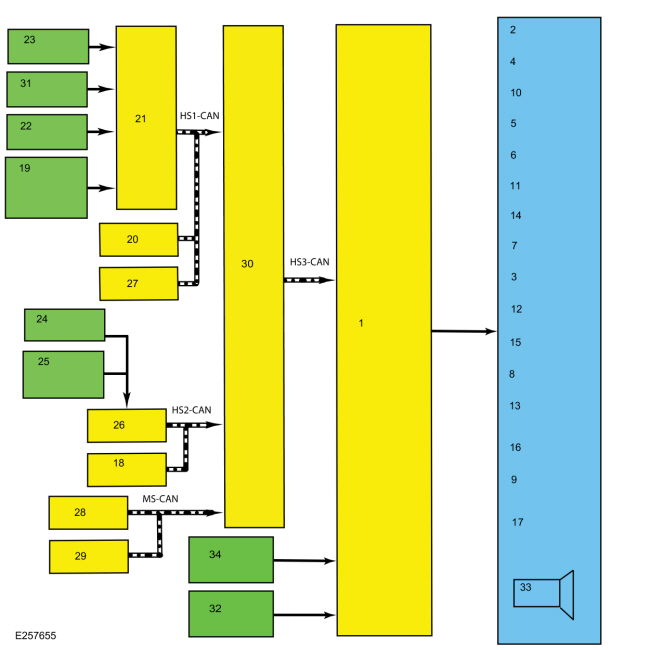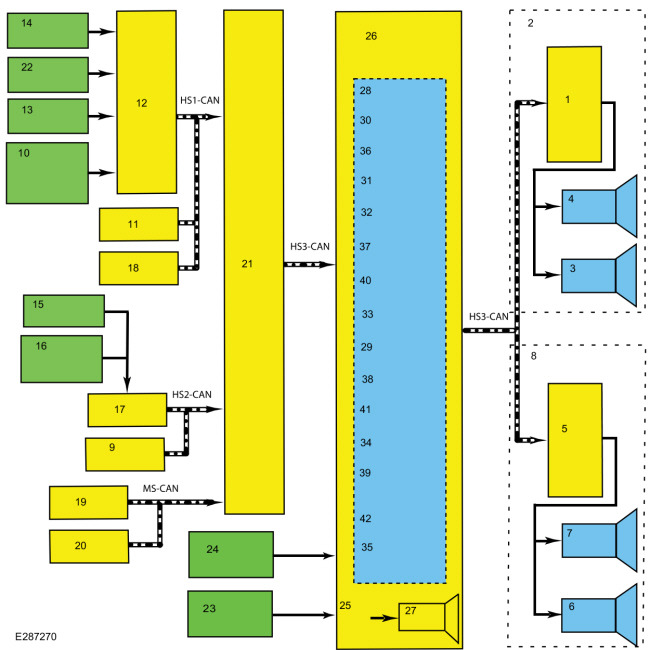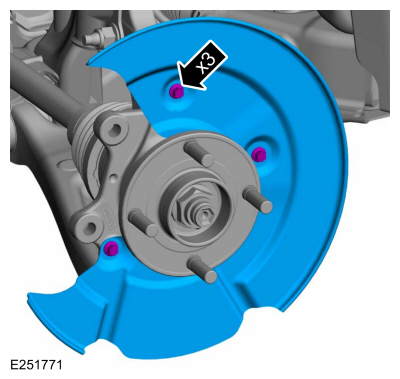Ford Ecosport: Instrumentation, Message Center and Warning Chimes / Description and Operation - Warning Chimes - System Operation and Component Description
System Operation
System Diagrams
Base AM/FM Audio System
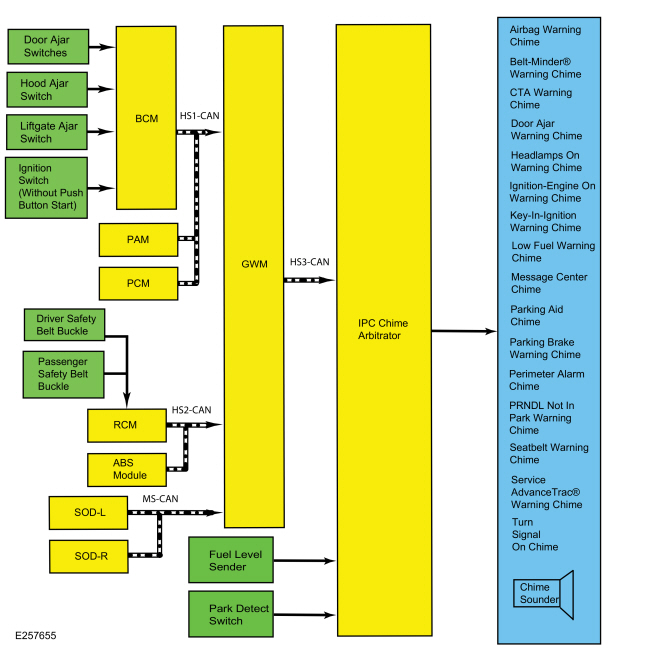
| Item | Description |
|---|---|
| 1 | IPC chime arbitrator |
| 2 | Airbag warning chime |
| 3 | Message center chime |
| 4 | Belt-Minder® warning chime |
| 5 | Door ajar warning chime |
| 6 | Headlamps on warning chime |
| 7 | Low fuel warning chime |
| 8 | Perimeter alarm chime |
| 9 | Service AdvanceTrac® warning chime |
| 10 | CTA warning chime |
| 11 | Ignition-engine on warning chime |
| 12 | Parking aid chime |
| 13 | PRNDL not in park warning chime |
| 14 | Key-in-ignition warning chime |
| 15 | Parking brake warning chime |
| 16 | Seatbelt warning chime |
| 17 | Turn signal on chime |
| 18 | ABS module |
| 19 | Ignition switch (without push button start) |
| 20 | PAM |
| 21 | BCM |
| 22 | Liftgate ajar switch |
| 23 | Door ajar switches |
| 24 | Driver safety belt buckle |
| 25 | Passenger safety belt buckle |
| 26 | RCM |
| 27 | PCM |
| 28 | SODL |
| 29 | SODR |
| 30 | GWM |
| 31 | Hood ajar switch |
| 32 | Park detect switch |
| 33 | Chime sounder |
| 34 | Fuel level sender |
Except Base AM/FM Audio System
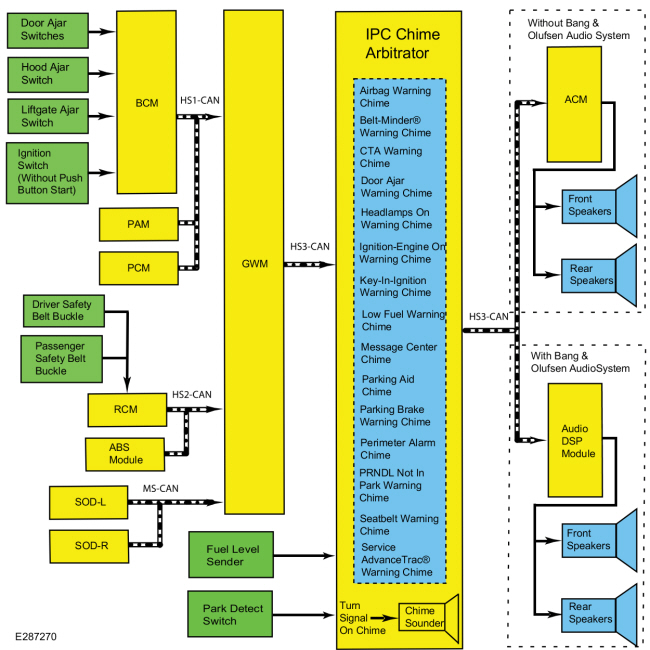
| Item | Description |
|---|---|
| 1 | ACM |
| 2 | Without Bang & Olufsen audio system |
| 3 | Rear speakers |
| 4 | Front speakers |
| 5 | DSP |
| 6 | Rear speakers |
| 7 | Front speakers |
| 8 | With Bang & Olufsen audio system |
| 9 | ABS module |
| 10 | Ignition switch (without push button start) |
| 11 | PAM |
| 12 | BCM |
| 13 | Liftgate ajar switch |
| 14 | Door ajar switches |
| 15 | Driver safety belt buckle |
| 16 | Passenger safety belt buckle |
| 17 | RCM |
| 18 | PCM |
| 19 | SODL |
| 20 | SODR |
| 21 | GWM |
| 22 | Hood ajar switch |
| 23 | Park detect switch |
| 24 | Fuel level sender |
| 25 | Turn signal on chime |
| 26 | IPC chime arbitrator |
| 27 | Chime sounder |
| 28 | Airbag warning chime |
| 29 | Message center chime |
| 30 | Belt-Minder® warning chime |
| 31 | Door ajar warning chime |
| 32 | Headlamps on warning chime |
| 33 | Low fuel warning chime |
| 34 | Perimeter alarm chime |
| 35 | Service AdvanceTrac® warning chime |
| 36 | CTA warning chime |
| 37 | Ignition-engine on warning chime |
| 38 | Parking aid chime |
| 39 | PRNDL not-in-park warning chime |
| 40 | Key-In-Ignition warning chime |
| 41 | Parking brake warning chime |
| 42 | Seatbelt warning chime |
Network Message Chart
Module Network Input Messages - Instrument Panel Cluster (IPC)
| Broadcast Message | Originating Module | Message Purpose |
|---|---|---|
| Accessory delay | BCM | Input used to control the overall chime function. |
| Audio chime status | ACM | Input used to control the source of the chimes based on ACM chime status. |
| Cross traffic alert left status | SODL | Input used to control the CTA warning chime. |
| Cross traffic left sensor status | SODL | Input used to control the CTA warning chime. |
| Cross traffic alert right status | SODR | Input used to control the CTA warning chime. |
| Cross traffic right sensor status | SODR | Input used to control the CTA warning chime. |
| Driver door ajar status | BCM | Input used to control the door ajar warning chime. |
| Driver seatbelt buckle status | RCM |
|
| Engine rpm data | PCM | Input used to control the chime volume request. |
| Gear lever position | PCM | Input used to control the Belt-Minder® chime. |
| Headlamp on warning chime | BCM | Input used to control the headlamp on warning chime. |
| Hood ajar status | BCM | Input used to control the door ajar warning chime. |
| Ignition status | BCM | Input used to control the overall chime function. |
| Key-in-ignition indicator status | BCM | Input used to control the key-in-ignition warning chime. |
| Left rear door ajar status | BCM | Input used to control the door ajar warning chime. |
| Left turn lamp on request | BCM | Input used to control the turn signal on warning chime. |
| Liftgate ajar status | BCM | Input used to control the door ajar warning chime. |
| Parking brake chime request | BCM | Input used to control the parking brake warning chime. |
| Passenger detect status | RCM | Input used for the passenger safety belt component of the Belt-Minder® chime. |
| Passenger door ajar status | BCM | Input used to wake up the chime modules on the CAN upon the door status change to open. |
| Passenger seatbelt buckle status | RCM | Input used for the passenger safety belt component of the Belt-Minder® chime. |
| Perimeter alarm chime request | BCM | Input used to control the perimeter alarm chime. |
| Power pack status | PCM | Input used for the ignition-engine on warning chime. |
| Rear parking aid chime request | PAM | Input used to control the parking aid chime. |
| Right rear door ajar status | BCM | Input used to control the door ajar warning chime. |
| Right turn lamp on request | BCM | Input used to control the turn signal on warning chime. |
| Side obstacle detect status-left | SODL | Input used to control the CTA warning chime. |
| Side obstacle detect status-right | SODR | Input used to control the CTA warning chime. |
| Stability-traction control chime request | ABS module | Input used to control the service AdvanceTrac® warning chime |
| Transmission gear display | PCM | Input used to control the PRNDL not in park warning message. |
| Transmission gear display mode | PCM |
|
| Vehicle speed | PCM |
|
Module Network Input Messages - ACM and DSP (Harmon Audio System)
| Broadcast Message | Originating Module | Message Purpose |
|---|---|---|
| Chime controls | IPC |
|
| Chime module power up | IPC | Input used to initiate the audio system as the chime source. |
| Chime source | IPC | Input used to configure the chime source (IPC or the audio system). |
| IPC chime request | IPC | Input from the IPC used to control the audio chime output. |
Warning Chimes And Chime Characteristics
With Base AM/FM Audio System
The IPC uses multiple network messages to control the overall warning chime arbitrator. The IPC arbitrates and controls all chimes regardless if they are sounded through the audio system or the IPC . The chimes are all sounded through the IPC since the ACM is not on the CAN .
The warning chimes use volume, chime frequency, length of time the chime sounds, length of off time between chime tones, decay of the chime tone and the number of chime tones to identify which chime is sounding. Most warning chimes have unique characteristics, however, there are chimes that do sound the same. The chime characteristics are defined by the different chime types:
- Information
- Soft-warning
- Hard-warning
- Tick-tock (on-off)
The IPC uses the following messages to control the warning chimes:
- Engine rpm data
- Driver door ajar status
- Passenger door ajar status
- Left rear door ajar status
- Right rear door ajar status
- Hood ajar status
- Liftgate ajar status
- Accessory delay
- Ignition status
The IPC receives the engine rpm data from the PCM and all door, hood and liftgate ajar status, accessory delay and ignition status messages from the BCM through the GWM over the HS-CAN3 .
Without Base AM/FM Audio System
The IPC uses multiple network messages to control the overall warning chime arbitrator. The IPC arbitrates and controls all chimes regardless if they are sounded through the audio system or the IPC . The warning chimes all sound through the audio system except for the turn signal tick-tock chime, which is sounded through the IPC . In the event of an audio system fault, the IPC sounds all chimes. The audio system has the ability to sound up to 2 chimes at a time while the IPC can only sound a single chime at a time.
The warning chimes use volume, chime frequency, length of time the chime sounds, length of off time between chime tones, decay of the chime tone and the number of chime tones to identify which chime is sounding. Most warning chimes have unique characteristics, however, there are chimes that do sound the same. The chime characteristics are defined by the different chime types:
- Information
- Soft-warning
- Hard-warning
- Tick-tock (on-off)
The IPC uses the following messages to control the warning chimes:
- Engine rpm data
- Driver door ajar status
- Passenger door ajar status
- Left rear door ajar status
- Right rear door ajar status
- Hood ajar status
- Liftgate ajar status
- Accessory delay
- Ignition status
- Audio chime status
The IPC sends the following messages to the ACM or DSP module (Harmon audio system only) control the warning chimes:
- IPC chime request
- Chime source
- Chime module power up
- Chime controls
The IPC receives the engine rpm data from the PCM and all door, hood and liftgate ajar status, accessory delay and ignition status messages from the BCM through the GWM over the HS-CAN3 . The IPC receives the audio chime status message from the ACM over the HS-CAN3 .
The IPC sends the IPC chime request, chime source, chime module power up and chime controls messages to the ACM or DSP module (Harmon audio system only) to control the chimes.
Airbag Warning Chime
The airbag secondary warning chime warns the driver that the airbag warning indicator LED is inoperative. If the IPC detects a fault with the airbag warning indicator LED during the bulb prove out, the airbag secondary warning chime sounds. If the IPC detects a fault in the airbag warning indicator when a SRS fault condition exists and the RCM has sent the IPC the airbag indicator request, the airbag secondary warning chime sounds. The airbag chime is a 0.5-second chime that sounds 5 times.
If not equipped with the base AM/FM audio system and a fault condition is detected, the IPC sends the IPC chime request message to the ACM and the DSP (Harmon audio system only) to sound the chime. The airbag secondary warning chime sounds through the front speakers.
Belt-Minder® Feature
NOTE: Whenever the vehicle is operated using MyKey®, the IPC enables the Belt-Minder®.
The Belt-Minder® is configurable on or off in all markets.
Refer
to: Seatbelt Minder Deactivating/Activating (413-01 Instrumentation,
Message Center and Warning Chimes, General Procedures).
The Belt-Minder® feature is controlled by the IPC supplementing the current seatbelt warning function and is enabled after the current seatbelt warning is complete. The Belt-Minder® reminds the driver that the driver or front passenger seatbelt is unbuckled by intermittently sounding a chime and simultaneously illuminating the seatbelt warning indicator. The Belt-Minder® begins once the current seatbelt warning has ended and the vehicle speed has exceeded 20 km/h (12 mph) (South America) or 10 km/h (6 mph) (except South America) with the driver or front passenger seatbelt unbuckled. While activated, the Belt-Minder® chime provides a series of chimes/seatbelt warning indicator flash sequences.
If the vehicle speed drops below 10 km/h (6 mph) (South America) or 5 km/h (3 mph) (except South America) once the Belt-Minder® chime has activated, the chime turns off and the seatbelt warning indicator remains on. When the vehicle speed exceeds 10 km/h (6 mph) again, the Belt-Minder® chime resumes.
The Belt-Minder® turns off when the ignition is transitioned to OFF, ACC or START, or after 4.5 minutes (270 seconds) has elapsed since the first Belt-Minder® warning occurred. Whenever the vehicle is placed in REVERSE (R), the Belt-Minder® is suspended but reactivates if the driver or passenger seatbelt(s) are unbuckled and vehicle speed exceeds 10 km/h (6 mph).
For all markets except South America, an additional feature of the Belt-Minder® is the toll booth feature. The toll booth feature allows the driver or passenger to unbuckle the seatbelt for 60 seconds (10 seconds when MyKey® is in use) then re-buckle before the Belt-Minder® chime reactivates.
When MyKey® is in use, the driver cannot configure the Belt-Minder® off. Once the Belt-Minder® is activated, the Belt-Minder® continues to chime periodically (does not time out after 5 minutes) and the audio system is muted until the driver and passenger seatbelts are fastened.
To control the Belt-Minder®, the IPC receives the vehicle speed, gear lever position, driver and passenger seatbelt buckle status and front passenger detect status messages from the GWM over the HS-CAN3 .
The GWM receives the vehicle speed and gear lever position messages from the PCM over the HS-CAN1 .
The IPC receives the driver seatbelt buckle status, passenger seatbelt buckle status and the front passenger detect status messages from the RCM over the HS-CAN2 .
If not equipped with the base AM/FM audio system and a chime request is received, the IPC sends the IPC chime request message to the ACM or the DSP (Harmon audio system only) to sound the chime through the front speakers.
CTA Warning Chime
The CTA warning chime sounds to alert the driver that a vehicle has been detected or that there is a system fault. The CTA warning chime sounds a 0.25-second chime continuously until the request is ended.
The IPC receives the CTA left status, the CTA right status, side obstacle detect status-left and the side obstacle detect status-right request messages from the GWM over the HS-CAN3 .
The GWM receives the CTA left status and the side obstacle detect status-left messages from the SODL over the MS-CAN .
The GWM receives the CTA right status and the side obstacle detect status-right request messages from the SODR over the MS-CAN .
If not equipped with the base AM/FM audio system and a chime request is received, the IPC sends the IPC chime request message to the ACM or DSP (Harmon audio system only) to sound the chime through the rear speakers.
Door Ajar Warning Chime
The door ajar warning chime warns that a door or liftgate is ajar and sounds the chime. When a door or the liftgate becomes ajar while the ignition is in RUN with vehicle speed greater than 5 km/h (3 mph), the IPC displays the appropriate door ajar warning message and sounds a single chime tone for each door opened. The door ajar chime only sounds once for each time the door is opened, and only repeats the chime if the door is closed then reopened.
The IPC receives the driver door ajar status, passenger door ajar status, left rear door ajar status, right rear door ajar status and liftgate ajar status message from the GWM over the HS-CAN3 . The GWM receives the driver door ajar status, passenger door ajar status, left rear door ajar status, right rear door ajar status or liftgate ajar status messages from the BCM over the HS-CAN1 .
If not equipped with the base AM/FM audio system and a chime request is received, the IPC sends the IPC chime request message to the ACM or the DSP (Harmon audio system only) to sound the chime through the front speakers.
Headlamps On Warning Chime
The headlamps on warning chime warns the headlamps are on when exiting the vehicle. When the driver exits the vehicle with the driver door ajar, the headlamp switch is in the PARK or HEADLAMP position and the ignition is OFF, the BCM sends the headlamp on warning chime message to the IPC through the GWM to sound the headlamps on chime. The headlamps on chime sounds a 1-second chime tone continuously.
The IPC receives the headlamp on warning chime request from the GWM over the HS-CAN3 .
The GWM receives the headlamp on warning chime request from the BCM over the HS-CAN1 .
If not equipped with the base AM/FM audio system and a chime request is received, the IPC sends the IPC chime request message to the ACM or the DSP (Harmon audio system only) to sound the chime through the front speakers.
Ignition-Engine On Warning Chime
The ignition-engine on chime informs the driver they are exiting the vehicle when the ignition has been left on (engine off) or the engine is running. When the driver exits the vehicle with the ignition on or with the engine running, the ignition-engine on warning chime sounds five 1-second chime tones. The IPC uses driver door ajar status, transmission gear display, power pack status and vehicle speed messaged inputs to control the ignition-engine on warning chime.
The IPC receives all required messages from the GWM over the HS-CAN3 .
The GWM receives the driver door ajar status message from the BCM over the HS-CAN1 .
The GWM receives the transmission gear display, power pack status and vehicle speed messages from the PCM over the HS-CAN1 .
If not equipped with the base AM/FM audio system and a chime request is received, the IPC sends the IPC chime request message to the ACM or the DSP (Harmon audio system only) to sound the chime through the front speakers.
Key-In-Ignition Status
The key-in-ignition warning chime warns the driver that the ignition is in ON or ACC when the driver door is ajar. The key-in-ignition warning chime sounds repetitive 0.5-second chime tones until the ignition is placed in OFF or the driver door is closed.
The IPC receives the key-in-ignition status from the GWM over the HS-CAN3 .
The GWM receives the key-in-ignition status from the BCM over the HS-CAN1 .
If not equipped with the base AM/FM audio system a chime request is received, the IPC sends the IPC chime request message to the ACM or the DSP (Harmon audio system only) to sound the chime through the front speakers.
Message Center Warning Chime
The message center warning chime feature draws the driver's attention to the message center display to view new warning messages. There are 3 different message center warning chime types that are defined by the length of the chime tone, which are designed to create a greater sense of urgency based on the nature of the condition and message displayed in the message center.
- Informational (1-second chime) - can be disabled by the driver through the message center
- Soft warning (0.5-second chime)
- Hard warning (0.25-second chime)
If not equipped with the base AM/FM audio system and a chime request is received, the IPC sends the IPC chime request message to the ACM or the DSP (Harmon audio system only) to sound the chime through the front speakers.
Parking Aid Chime
The parking aid system uses a visual display in the FDIM and a chime to alert the driver objects are close to the vehicle. The parking aid chime sounds a repetitive chime tone that decreases the time off between chime tones as objects get closer to the sensor until a continuous tone.
The IPC receives the parking aid chime request from the GWM over the HS-CAN3 .
The GWM receives the parking aid chime request from the PAM over the HS-CAN1 .
If not equipped with the base AM/FM audio system and a chime request is received, the IPC sends the IPC chime request message to the ACM or the DSP (Harmon audio system only) to sound the chime through the rear speakers.
Parking Brake Warning Chime
The parking brake warning chime warns the parking brake is engaged when the vehicle is in motion. The parking brake warning chime sounds if the ignition is in RUN, the parking brake is engaged, and the vehicle speed is greater than 5 km/h (3 mph). The parking brake warning chime stops sounding and resets if the parking brake is released, the ignition is not in RUN, the vehicle speed is less than 5 km/h (3 mph), or after 90 seconds from the time the chime is activated. The parking brake warning chime sounds a repetitive 0.5 second chime tone.
The IPC receives the parking brake chime request from the GWM over the HS-CAN3 .
The GWM receives the parking brake chime request from the ABS module over the HS-CAN1 .
If not equipped with the base AM/FM audio system and a chime request is received, the IPC sends the IPC chime request message to the ACM or the DSP (Harmon audio system only) to sound the chime through the front speakers.
Perimeter Alarm Warning Chime
The perimeter alarm warning chime alerts the driver the perimeter alarm is armed when the driver door is unlocked before disarming the alarm. The IPC displays a perimeter alarm message in the message center and the perimeter alarm warning chime sounds for 12 1-second chime tones when the driver door is opened. The perimeter alarm warning chime turns off when the perimeter alarm is disarmed (either by using the key fob or turning the key to the ON position). After the twelve second warning chime duration, the warning chime stops sounding and the perimeter alarm activates, sounding the horn and flashing the turn signal lamps.
The IPC receives the perimeter alarm warning chime request from the GWM over the HS-CAN3 .
The GWM receives the perimeter alarm warning chime request from the BCM over the HS-CAN1 .
If not equipped with the base AM/FM audio system and a chime request is received, the IPC sends the IPC chime request message to the ACM or the DSP (Harmon audio system only) to sound the chime through the front speakers.
PRNDL Not In Park Warning Chime
The IPC provides a PRNDL not in park warning chime that sounds along with the transmission not in park message center warning message to inform the driver the vehicle is not in PARK (P). The IPC displays the shift to park message and the PRNDL not in park warning chime sounds three 0.5-second chime tones if the selector lever is not in PARK (P), the ignition is OFF and the driver door is open or ajar. The IPC requires the transmission shift mode display, transport mode vehicle speed, driver door ajar and ignition status to control the PRNDL not in park warning chime.
The
PRNDL not in park chime uses the same inputs controlling the PRNDL not
in park warning message. Refer to Shift To Park Message Display for
network message details.
Refer to: Message Center - System Operation
and Component Description (413-01 Instrumentation, Message Center and
Warning Chimes, Description and Operation).
If not equipped with the base AM/FM audio system and a chime request is received, the IPC sends the IPC chime request message to the ACM or the DSP (Harmon audio system only) to sound the chime through the front speakers.
Seatbelt Warning Chime
The seatbelt warning chime warns the seatbelt is not fastened. The seatbelt warning chime sounds a repetitive 1-second chime tone for 6 seconds when the driver seatbelt is not fastened and the ignition is transitioned from OFF or ACC to ON or START. The seatbelt warning chime stops sounding when the seatbelt is fastened, when the ignition is transitioned from ON or START to OFF or ACC, or when the chime has sounded for 6 seconds.
The IPC receives the driver seatbelt buckle status message from the GWM over the HS-CAN3 .
The GWM receives the driver seatbelt buckle status from the RCM over the HS-CAN2 .
If not equipped with the base AM/FM audio system and a chime request is received, the IPC sends the IPC chime request message to the ACM or the DSP (Harmon audio system only) to sound the chime through the front speakers.
Service AdvanceTrac® Warning Chime
The service AdvanceTrac® warning chime warns the ABS module has detected a fault condition in the stability control system. If a fault condition exists in the stability-traction control system, the ABS module sends the IPC the AdvanceTrac® warning chime request to display SERVICE ADVANCETRAC in the message center and to sound the chime.
The service AdvanceTrac® warning chime sounds three 0.5-second chime tones.
The IPC receives the stability-traction control chime request from the GWM over the HS-CAN3 .
The GWM receives the stability-traction control chime request from the ABS module over the HS-CAN2 .
If not equipped with the base AM/FM audio system and a chime request is received, the IPC sends the IPC chime request message to the ACM or the DSP (Harmon audio system only) to sound the chime through the front speakers.
Turn Signal/Hazard On Chime Tone
The IPC provides a repetitive 1-second on/off tick-tock chime tone along with visual RH or LH turn indicators to inform the driver the turn signal or hazard lamp function is on.
The IPC receives the left turn indicator status and right turn indicator status messages from the GWM over the HS-CAN3 .
The GWM receives the left turn indicator status and right turn indicator status messages from the BCM over the HS-CAN1 .
 Description and Operation - Warning Chimes - Overview
Description and Operation - Warning Chimes - Overview
Overview
The warning chimes provide the driver with audible warnings that act
as reminders and supplemental alerts to visual IPC indications such as
gauges, indicators and message center warnings...
 Diagnosis and Testing - Instrumentation, Message Center and Warning Chimes
Diagnosis and Testing - Instrumentation, Message Center and Warning Chimes
DTC Chart: Instrument Panel Cluster (IPC)
Diagnostics in this manual assume a certain skill level and knowledge of Ford-specific diagnostic practices...
Other information:
Ford Ecosport 2014-2025 Service and Repair Manual: Removal and Installation - Transmission Support Insulator
Special Tool(s) / General Equipment 303-F072Support Bar, Engine Materials Name Specification Motorcraft® Threadlock and SealerTA-25-B - Motorcraft® Silicone Brake Caliper Grease and Dielectric CompoundXG-3-A ESA-M1C200-AESE-M1C171-A Removal With the vehicle in NEUTRAL, position it on a hoist...
Ford Ecosport 2014-2025 Service and Repair Manual: Removal and Installation - High Mounted Stoplamp
Removal NOTICE: Washer fluid may escape. Release the clips and remove the high mounted stop lamp. Disconnect the electrical connector. Installation To install, reverse the removal procedure...

